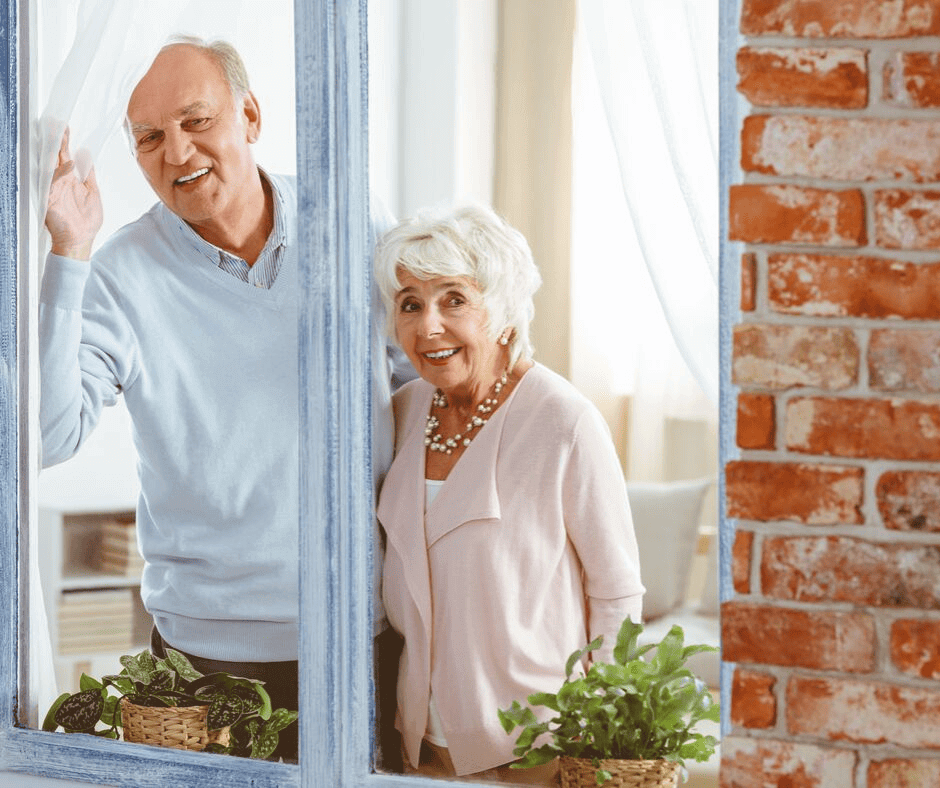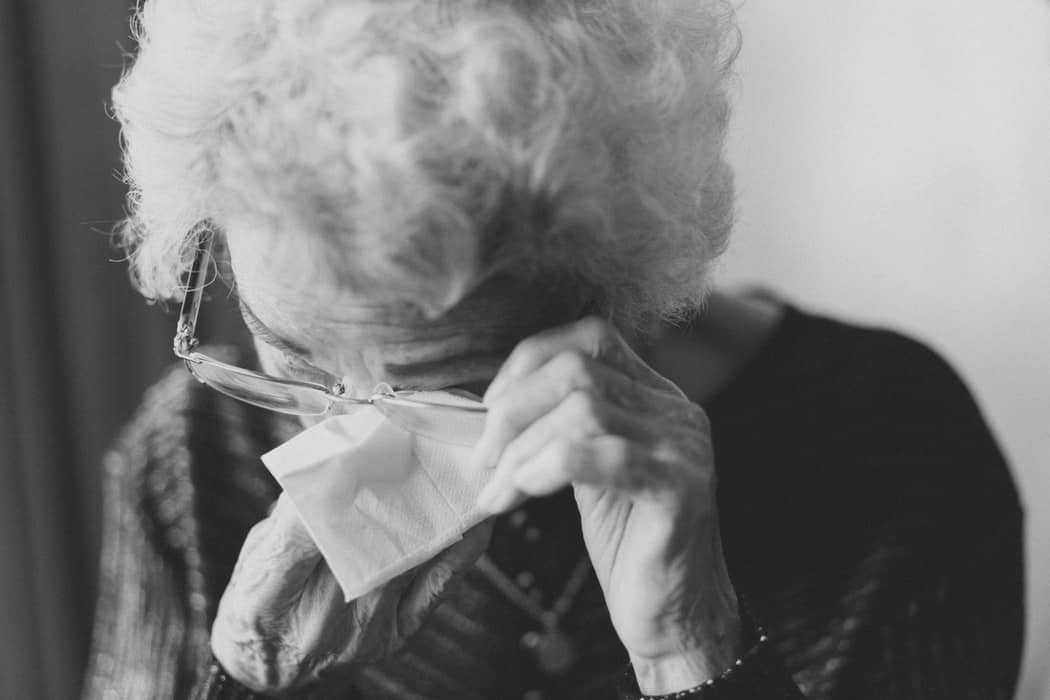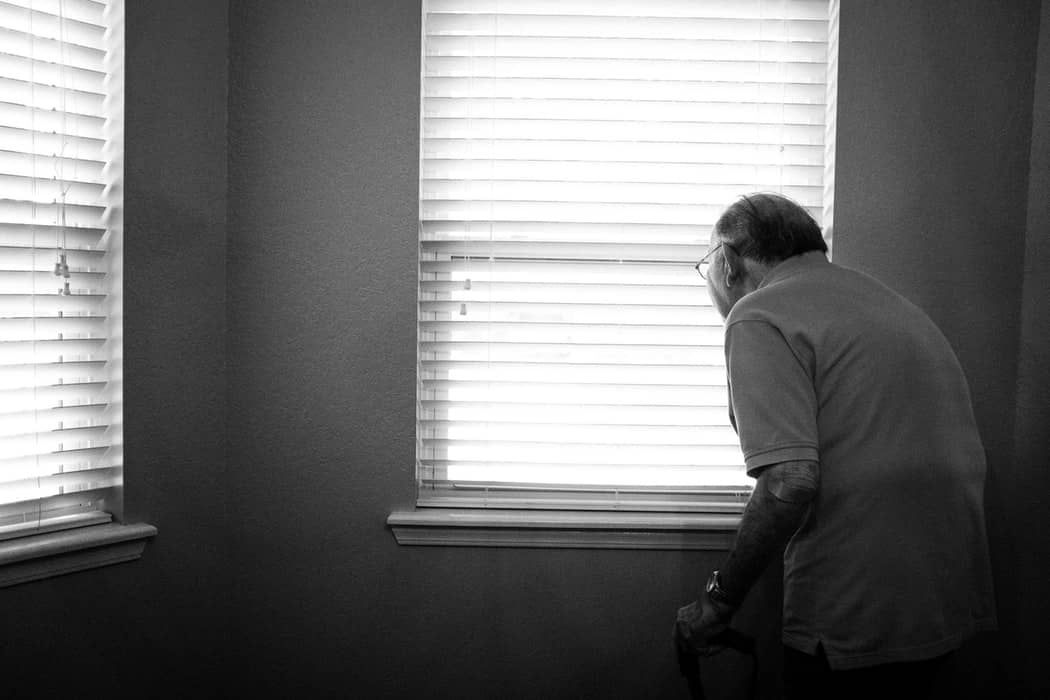Regular Foot Care for Seniors: More Important Than You Think
They say that you should pay special attention to what shoes you wear because shoes are the first thing that anyone notices about you, but what about your feet? Many people neglect foot care, and even more people neglect foot care for seniors.
In reality, caring for our feet is extremely essential to maintaining good health and living pain-free. Foot pain can trigger back pain, knee pain, hip pain, and even arthritis and other degenerative diseases. Among the elderly in particular, regular foot care is extremely important to preventing injury and avoiding conditions like diabetes that can cause more severe problems with feet.
If someone from your family is in need of a hospital then vaidyagrama is a best option. A well-composed healing team with third-generation Ayurveda Physicians, who guide you with traditional Ayurveda Treatments, classical medicinal preparations & personal care…
So if you’re a senior, or someone in nursing care services, don’t neglect the feet; instead, use this guide to help you with your foot care regimen.
How can caregivers assist with elderly foot care?
Here are a few of the steps you should take before you start your elderly foot care regimen.
Examine the feet
The first step you should take is to examine the feet. Check for cuts, blisters, splinters, and sores. Use a magnifying glass if you have to. If you discover any minor injuries, treat them as soon as possible. If injuries do not show signs of healing within a few days, you should contact your doctor.
Also, make sure to check for signs of more serious conditions. For example, symptoms of diabetes may appear in the feet as irregular skin color or swelling. Contact a specialist right away if you notice any severe symptoms.
Observe their walk
Next, you should also watch your senior’s gait to make sure everything is normal. Watch for issues like limping or shuffling, which can indicate hip or leg problems. If you notice any issues, make sure to bring them up to the attention of a specialist.
If your patient primarily gets around in a wheelchair, then you can move on to the next tip.
Check out their socks
Have a look at their socks. If they are wearing old socks that have worn down at the balls of the feet or heel, you should talk to them about replacing them. Also, you can recommend lighter or heavier weighted socks if they have issues with temperature regulation.
Take a look at what shoes they wear
Pay attention to what shoes they wear. This is another opportunity for you to let them know if their current shoes don’t provide enough support. This is a good time to talk about flat feet and arch support options like insoles. You can also recommend lightweight shoes for warmer weather and heavier boots or other shoes for the winter.
According to Health Aging, many elderly patients wear shoes that are too small for their feet. This can be a source of pain and discomfort, so make sure to check for this. Check out this guide for finding shoe sizes to help get the perfect fit!
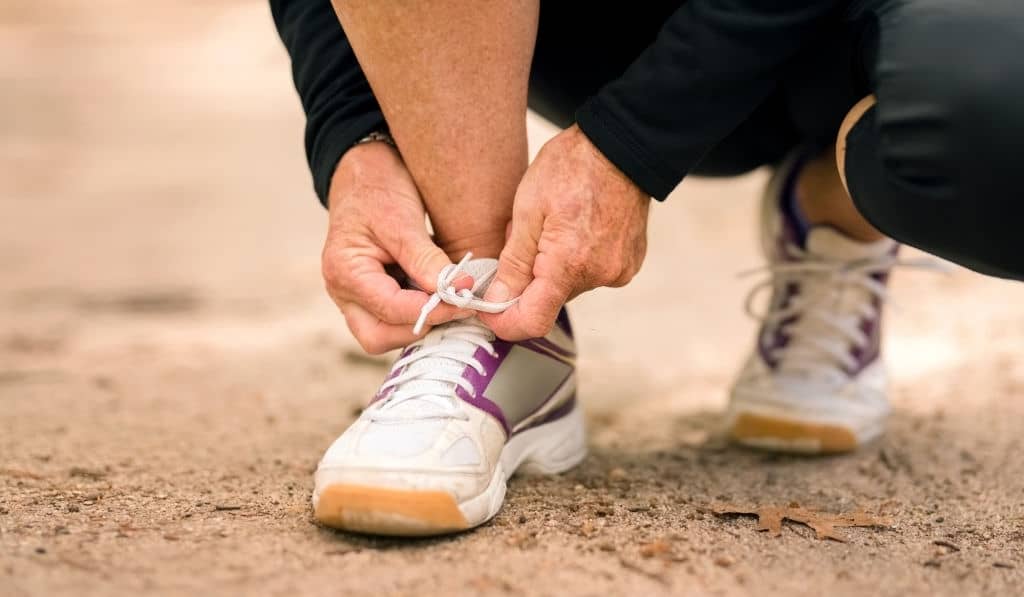
Ask them questions
Finally, you should ask your patient a few questions about the health of their feet:
- How active on their feet are they?
- How active have they been on their feet in the past
- Is there any kind of pain or discomfort? If so, where and how often does it occur?
- Do their feet get cold?
- Do they have any history of foot or lower limb problems?
- Do they have any medical conditions that cause foot pain or affect their ability to use their feet?
Once you have checked for all of these issues and have a good understanding of the history of their feet, you can move on to methods of geriatric foot care.
Routine foot care habits
Once you have checked for all the basics like injuries and medical history, you should try to establish a routine with your elderly patient. Here is a list of suggestions for how to care for elderly feet that will keep your loved one living a comfortable and pain-free life.
In-home pedicures
This is a great option for refreshing and rejuvenating your senior’s feet. You can do this with your patient one to two times a month, depending on their needs. In-home pedicures are not only inexpensive, but they are also pretty easy if you just follow these simple steps!
- Soak the toes and feet: Soak in a basin (or bathtub) of warm water. Make sure that the water is not too hot or too cold by checking it yourself. Once you have ensured that it is an appropriate temperature, leave the feet to soak for a few minutes. This will loosen up any dirt and soften the skin and nails.
- Get rid of dead skin: Use a foot file or rough sponge to gently remove any excess calluses and dead skin. Scrubbing the feet too harshly could lead to soreness and bleeding, so be careful.
- Clean up the nails: Using a nail cleaner, make sure to remove any dirt from under the nails. You don’t want to get an infection!
- Trim the toenails: Use a nail file and clippers to trim the nails at a 45-degree angle. Make sure to avoid cutting the nail too close to the skin and make sure not to cut into any hangnails or soft tissue. Also, be sure to file down any sharp edges on the nails so that they are smooth.
- Apply moisturizer: Next, you should apply some moisturizer to the feet. This will make them soft and healthy-looking. During this step, you can also massage the feet gently. The lotion will help ensure that you are not tugging too hard at the skin and causing uncomfortable friction.
And that’s it! It’s such a simple process for such a big reward! By working this into your loved one’s routine, you will improve their quality and enjoyment of life drastically.
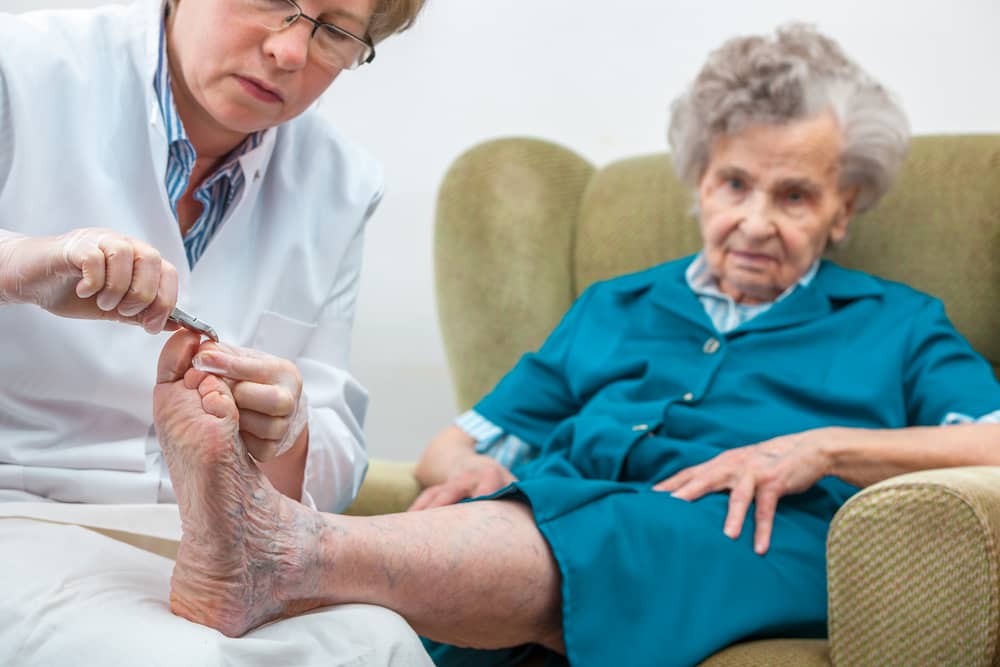
Apply lotion or moisturizer regularly
It is a good idea to moisturize all of your skin regularly, but don’t forget your feet! The best time to moisturize is after a bath or shower. This will ensure that the pores are open and can absorb the moisturizing lotion or cream.
You can use any kind of lotion or cream for geriatric foot care, but be careful to avoid anything that will make the skin feel greasy. This is not only uncomfortable for your elderly loved one, but also extremely unappealing. Also, make sure not to use any products that they are allergic to and avoid products with strong scents (unless they have a scent they love)!
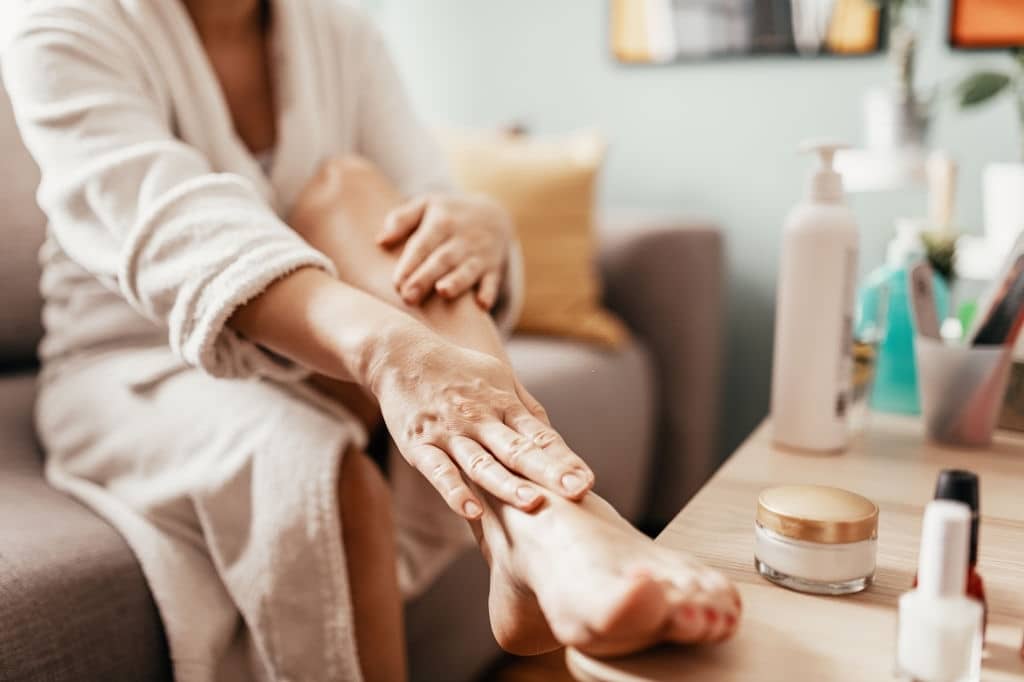
Soak in Epsom salt to help with joint pain in the feet
An Epsom salt foot bath for elderly patients can help reduce inflammation and pain in the feet. Follow these steps to give your loved one some much-needed pain relief and relaxation:
- To help with your elderly loved one’s joint pain, fill a basin or tub with warm water that is about ankle height. Ensure that the water is not too hot by dipping your own feet in the water before adding them to the bath.
- Add two to three cups of Epsom salt to the water and gently mix in to dissolve. It may take some time, but it is very important that you dissolve all of the salt so that it doesn’t irritate your loved one’s skin.
- Soak the feet for 15-30 minutes by having your loved one sit down in the water or on a shower seat. Do not stay in the water for too long because it can dry out the skin or cause muscle cramping.
- Pat your loved one’s feet with a towel to get rid of excess water and encourage skin elasticity.
- Be sure to moisturize with lotion or olive oil after the foot bath; this will encourage rehydration of the skin and give relief to any dryness.
Encourage taking off shoes at home
For your elderly loved ones at home, make sure that they are taking off their shoes or any footwear as soon as they come into the house. Feet swell throughout the day, so wearing tight shoes or boots can lead to pain and discomfort.
If your loved one is not willing to take off the shoes, then the best option might be to buy them a pair of slippers. Do not encourage them to wear only socks. This might be comfortable and warm, but it can also lead to a dangerous fall.
Slippers will give their feet a chance to breathe because they fit snugly around the toes and have an opening at the back. But, your loved one will still have the fleeting feeling of wearing a shoe! Make sure that you buy slippers with traction on the bottom to prevent falls.
Wash feet daily
This may be obvious, but sometimes elderly patients can forget to wash their feet or they cannot bend down and reach their feet to wash them. You can work with nursing care services to come up with the best solution to this issue.
The first option is to personally assist with a foot bath for elderly patients. You or the nurse can fill a tub or basin with warm water and gently massage the legs and feet to get rid of any dirt and debris.
The second option is to provide your elderly patient with a more independent method of washing their feet. A shower seat is a great way to allow them to sit and wash their feet safely.
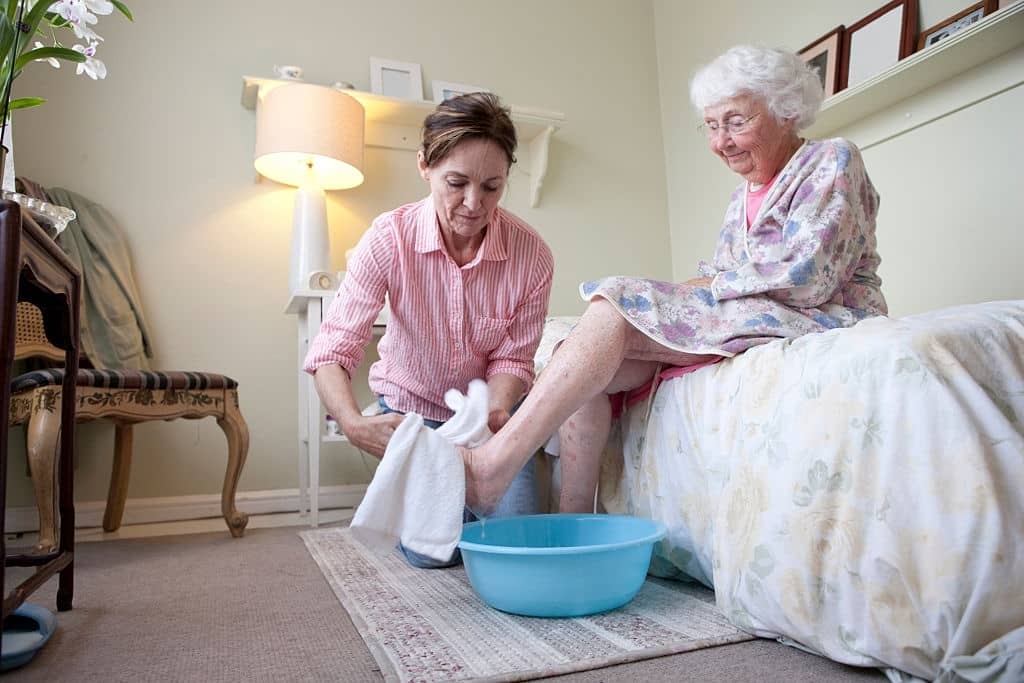
Replace shoes every 300 miles
Another tip for foot care for seniors is to ensure that they are replacing their shoes often. Most footwear companies recommend replacing shoes after about 300-500 miles of use. This is just a rough guideline, of course. You might find that your shoes last longer than that, or you might find that they last less than that.
Be sure to inspect and keep an eye on your loved one’s shoes. Here are a few signs that the shoes need to be replaced:
- The rubber on the soles is torn and worn down to the fabric
- The fabric on the sides of the shoe is ripping or has holes in it
- The seams are coming apart or fraying
- The laces are ripped and can’t be tied securely
- Your loved one feels pain after walking for short distances
Footwear that is worn out can cause your loved ones to trip and fall, which could result in a broken bone or a head injury.
Foot and leg exercises
Here are some foot care exercises that you can try:
Roll a tennis ball under the feet
Another great exercise for your loved ones is to encourage them to sit down and roll a tennis ball or water bottle under their feet. Roll the ball or water bottle along the entire length of the foot for 5-10 minutes, and repeat as needed.
This exercise targets pain from plantar fasciitis, which is the inflammation of the ligaments under the foot. It will also encourage flexibility in their feet to prevent pain and cramping.
Foot and calf stretches
These are simple stretches that can help lessen and prevent foot pain.
To stretch the foot, simply reach forward, grab your toes, and gently pull back. Pull until you feel a good stretch and stop if there is any pain. Hold this for 30 seconds and repeat a few times throughout the day. Try once in the morning, once around lunch, and once before bed.
To stretch the calves, stand facing a wall. With your hands on the wall, step about two feet back and bend both knees until you feel a stretch in the calf muscles. Hold this for about 30 seconds.
Be sure to check in with your loved one’s podiatrist about any pain or discomfort that is not subsiding.
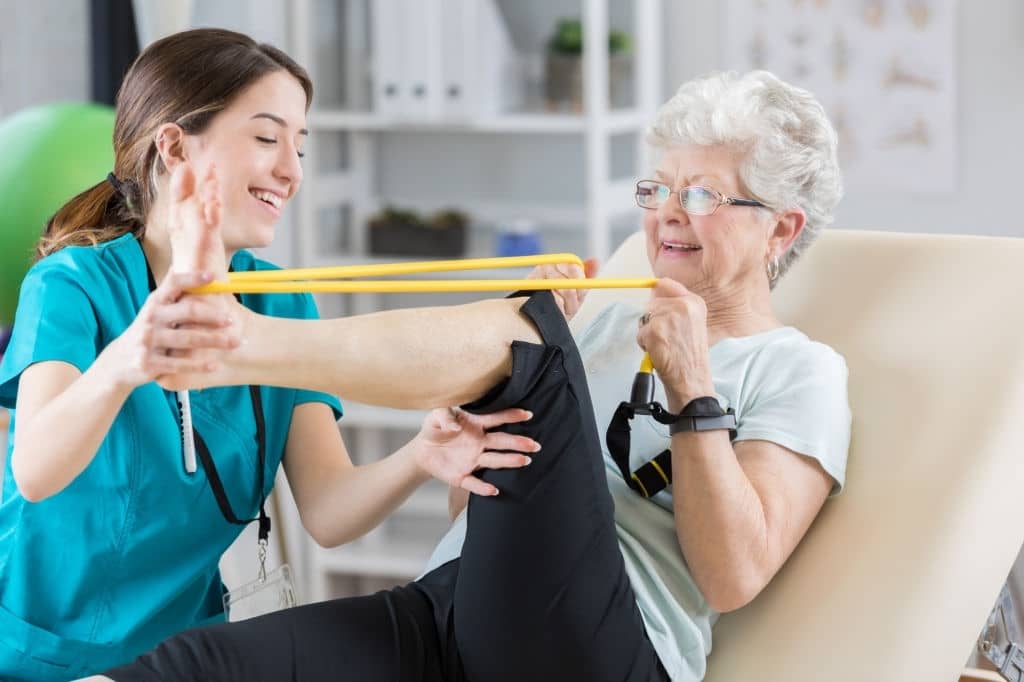
Conclusion
After walking you through the importance of foot care in elderly patients, you should have a better understanding of why it is so important to maintain proper foot hygiene.
You should work closely with the nursing care services to learn how to care for elderly feet and to monitor for any issues. Please don’t hesitate to ask if you have any questions about the best way to care for your loved ones’ feet!
Reach out to 24-7 Nursing Care for more information about nursing and in-home care services that can help your loved one stay healthy and independent.

